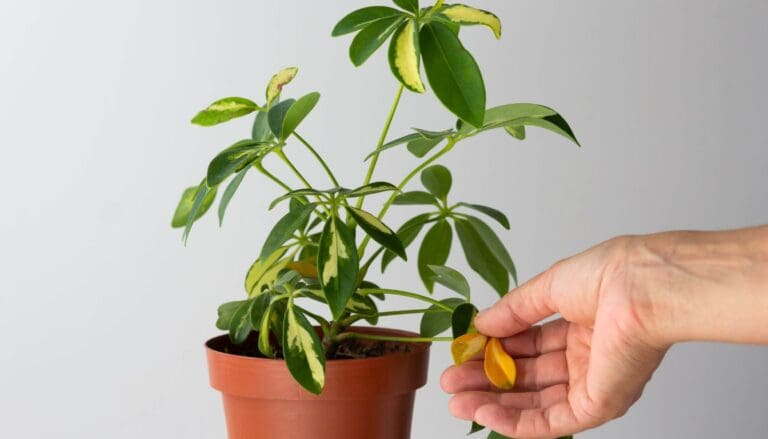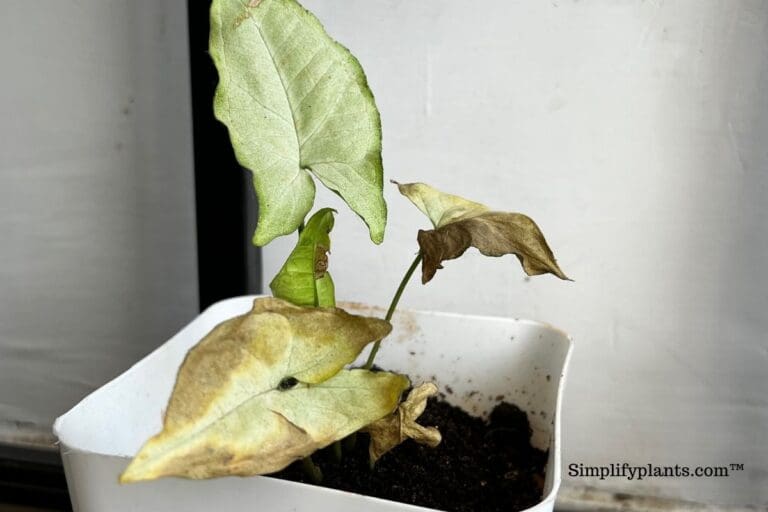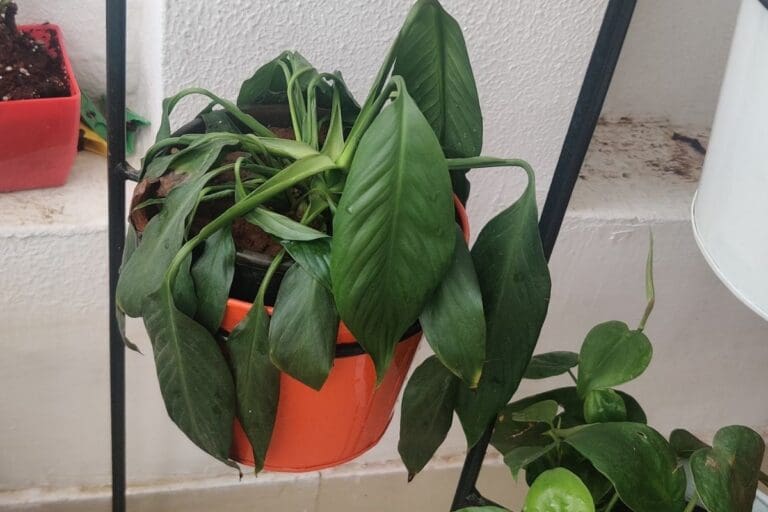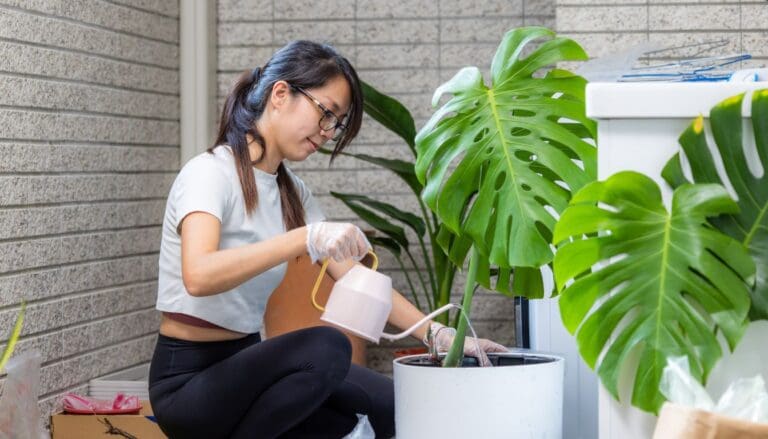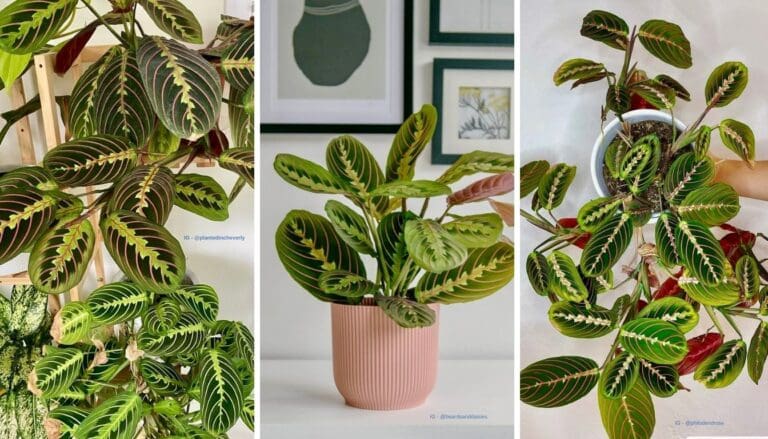Calathea Zebra Plant Care: Easy Tips for Thriving Indoor Beauty
Caring for a Calathea Zebra Plant can be a bit tricky, but it’s totally worth it! This tropical houseplant is famous for its stunning striped leaves, adding a touch of jungle to your home.
Are you ready to turn your space into a green paradise? 😊
I love how these plants thrive in bright, indirect light and prefer their soil to be well-draining and loamy.
Keeping the humidity high is key, so consider adding a humidifier or misting the leaves.
Have you tried giving your plants a shower? They love it!
Watering can be tricky, but here’s a tip: let the top inch of soil dry out before you water again.
Overwatering can be a real problem, leading to root rot.
What’s your go-to plant care hack? Drop your favorite tips in the comments below! 🌿✨

Please note: Simplify Plants is reader-supported. As an Amazon Associate, I earn from qualifying purchases made by our readers with no extra cost added to you all! Some links in the post are affiliate links and I get a commission from purchases made through links in the post.
Calathea Zebra Plant Overview
The Calathea Zebra Plant is a stunning houseplant known for its unique and vibrant foliage. Its leaves display beautiful green stripes resembling a zebra’s pattern, which always catches my eye.
I love to keep plants that aren’t just pretty but also safe for my furry friends. Great news! This plant is non-toxic to both pets and people. 🌿
Do you hate dealing with pests? The Zebra Plant can attract unwanted guests like aphids, mealybugs, scale, and spider mites.
Don’t worry! I find that regular checks and treatments help keep them in check.
Here’s what I’ve learned about its growth: the plant can grow up to 3 feet tall.
I make sure it gets enough space. Its leaves grow from basal rosettes, which means they spread out beautifully from a central point. Pretty cool, right?
Quick Care Guide
Here’s a quick checklist I use to keep my Calathea Zebra Plant happy:
- Light: Bright, indirect light. Too much sun can scorch the leaves.
- Soil: Well-draining and loamy soil is a must.
- Water: Regular watering. I water mine when the top 1-2 inches of soil are dry.
- Fertilizer: Skip it unless the plant’s growth seems stunted.
Have you had any interesting experiences with your Calathea Zebra Plant? 🌱 Drop a comment below and let’s share tips!
Optimal Growing Conditions

Let’s talk about the best conditions to help your Calathea Zebra plant thrive. This plant needs specific light, temperature, and humidity levels to grow well indoors. 🌿✨
Light Requirements
The Calathea Zebra plant loves bright, indirect light. Imagine it catching the morning sun filtered through sheer curtains.
It shouldn’t be placed in direct sunlight because this can cause the leaves to fade or scorch.
You can put it near a north or east-facing window.
If you notice the leaves getting pale or brown at the edges, it might be getting too much sun.
Artificial grow lights can also work if natural light is limited.
A simple rule of thumb: If you are comfortable in the room, so is your Calathea!
Temperature Ranges
The sweet spot for your Calathea Zebra plant is between 65-85°F (18-29°C).
I find this range works great for most indoor settings.
Just keep it away from cold drafts, AC vents, or heaters, which can stress the plant. ❄️🔥
Imagine the cozy, consistent temperature of a tropical forest.
Try to avoid sudden changes in temperature.
If you see the leaves curling or becoming limp, it might be too cold.
Keeping a stable temperature will make your Calathea a happy camper.
Humidity Levels
Humidity is super important for Calathea Zebrina. Think high humidity, like 60% or more.
I have found that a humidifier works wonders, especially in dry climates or winter. 🏞️💧
Placing a water-filled pebble tray underneath the pot is another trick to boost humidity.
Grouping your plant with other houseplants can also help create a micro-humid environment.
If the leaf edges start browning, it’s likely due to low humidity. Keep those leaves misted and fresh!
Plant Care Routine

Taking care of Calathea zebrina involves regular watering, proper fertilizing, and occasional pruning to keep it thriving and looking its best. Let’s dive into the specifics!
Watering Practices
Watering your Calathea zebrina can be tricky but crucial for healthy growth. 🪴 This plant loves moist soil but hates being waterlogged.
I wait until the top inch of soil is dry before giving it a drink. Using room-temperature, distilled water or rainwater helps avoid harmful chemicals.
Overwatering can lead to root rot, so make sure your pot has drainage holes.
In winter, the plant needs less water, so adjust accordingly.
Do you check the soil with your finger to decide when to water? I find it’s the best way!
Fertilizing Methods
Fertilizing Calathea zebrina is a must during its growing season. 🌱
I use a balanced, water-soluble fertilizer once a month from spring through early autumn. This gives the plant the nutrients it needs to produce vibrant foliage.
Be cautious with the amount—less is more. An overdose can burn the roots and harm the plant.
In winter, I skip feeding because the plant’s growth slows down.
Do you have a favorite fertilizer brand? Share in the comments!
Pruning Guidelines
Pruning helps keep your zebra plant in shape and prevents diseases. ✂️
I remove any yellow or brown leaves as soon as I notice them. This not only makes the plant look better but also redirects energy to healthier parts.
Using clean, sharp scissors prevents infections.
Regularly inspecting your plant for pests like aphids or spider mites is also part of good pruning practice.
Found any sneaky bugs on your plant lately? Let’s talk about it!
Potting and Soil Composition

When it comes to potting and soil for the Calathea Zebra plant, getting the right mix and repotting at the right time are key. Proper soil composition ensures the plant gets the nutrients and drainage it needs to thrive.
Soil Types
For the Calathea Zebra, a well-draining soil is a must.
I always recommend a loamy mix rich in organic matter. This means using a blend of peat moss, perlite, and vermiculite.
These ingredients help retain moisture without making the soil too soggy.
A slightly acidic pH between 5.5 and 6.5 makes the plant happiest.
You can find pre-mixed bags that cater to calatheas, or you can mix your own. 😊
Just make sure it doesn’t compact too much, which can suffocate the roots.
Have you tried mixing your own soil before? Let me know!
Repotting Tips
When it comes to repotting, it’s best to do this every 1-2 years or when the plant seems outgrown its pot.
Signs include roots poking out from the bottom, or slowed growth.
I usually pick a pot that’s only one size larger than the current one to avoid too much extra soil, which can hold excess moisture.
Gently remove the plant from its old pot, shaking off excess soil.
Place it in the new pot at the same depth as before, and fill around with fresh potting mix, firming gently.
Water thoroughly to settle the soil and eliminate air pockets.
Ever faced a tricky repotting situation? Share your anecdotes below! 🌱
Troubleshooting Common Issues

Caring for Calathea Zebra Plant can be rewarding but sometimes, problems arise. Let’s dive into how to tackle pests, diseases, and leaf discoloration to keep your plant thriving. 🌿
Pest Prevention
Pesky spider mites and aphids love to bother our plants.
I find that regularly checking my Calathea zebra for these pests is crucial. Look for fine webs or tiny bugs on the leaves. If you spot any, it’s time to take action.
Mix a solution of water and mild soap (a drop or two per quart).
Spray this on the affected leaves and wipe gently.
Alternatively, neem oil is a great option for natural pest control. 🧼
Keep your plant in high humidity and ensure good air circulation. This can deter pests from making your plant their home.
Do you have any tips for fighting pests? Share them below! 👇
Disease Management
Diseases like root rot can sneak up on us.
Overwatering is often the culprit.
I make sure the soil isn’t too wet by letting the top inch or two dry out before watering again.
Also, using a pot with good drainage helps a lot.
If you notice any yellowing leaves or a foul smell from the soil, it’s best to check the roots.
Healthy roots are white and firm, while diseased ones are brown and mushy.
If you find any bad roots, trim them and repot the plant in fresh, well-draining soil. 🪴
How do you prevent diseases in your plants? I’d love to hear your methods!
Leaf Discoloration
Leaf discoloration on Calathea zebrina is a common issue.
Brown leaf tips? Often, this means the air is too dry.
Boost the humidity around your plant by using a humidifier or placing a tray of water nearby.
If the leaves are turning yellow, it might be a sign of overwatering or insufficient light.
I try moving my plant to a spot with bright, indirect light and adjusting watering habits.
Ever dealt with leaf discoloration? It’s frustrating, right? Let’s discuss ways to keep our plants looking green and gorgeous! 🌱✨
Got any more Calathea care tips? I’d love to read your thoughts in the comments. Let’s help each other grow the best plants! 🌿🌟
Propagation Techniques

So, you’ve got a beautiful Calathea Zebra, and now you’re thinking about growing more. Awesome! 🌱
Let me walk you through propagation.
First, the best method for propagating this plant is division. It’s simple and effective.
Pick the right time, usually late spring, when the plant’s all pepped up and growing.
Step 1: Gently unpot your Calathea.
Sometimes, a little tip helps—place your hand around the base, tip the pot, and squeeze around the sides to loosen the roots. This will help ease the plant out.
Step 2: Carefully divide the plant into sections.
Each division should have at least one stem and a good amount of roots. Don’t worry if it looks a bit tricky at first.
Step 3: Plant each division in separate pots with fresh potting soil.
Make sure the roots are covered and the plant is stable. Water them thoroughly to settle the soil. 🚿
Step 4: Place these new pots in a spot with bright, indirect light.
It’s like giving them a cozy corner to start their new life. Remember to keep the soil moist but not soggy.
FAQs and Tips

How often should I water my Calathea Zebrina?
Water regularly when the top 1-2 inches of soil feels dry.
During warmer months, this might be 2-3 times a week. In cooler months, reduce this to 1-2 times a week.
What kind of soil is best?
Choose loamy, well-draining soil. You can buy it or make your own blend. We don’t want our little friend sitting in water for too long! 😉
What is the ideal light condition for my plant?
Place your Calathea Zebrina in a spot with bright, indirect light.
Too much direct sunlight can harm it, so be careful where you place it initially.
How do I keep the humidity levels high?
High humidity is a must!
Use a humidifier, mist the plant regularly, or even group it with other plants. Your Calathea will love the extra moisture.
What temperatures does my Calathea Zebrina prefer?
Maintain temperatures between 65-75°F (18-24°C). Avoid letting it drop below 60°F (15°C). And no drafts, please!
What pests should I watch out for?
Keep an eye out for aphids, mealybugs, scale, and spider mites.
A quick rinse with diluted dish soap can help if you spot any.
Do I need to fertilize my Calathea Zebrina?
Fertilizing isn’t usually necessary unless you notice slow growth. In that case, a half-strength, balanced fertilizer can help. 🌿
Ever thought about giving your plant a shower?
Yes, you heard it right!
A gentle shower can help clean the leaves and keep pests at bay. Plus, it mimics a tropical rain!
Got any tips or tricks?
Please share them in the comments below! Let’s help each other grow happy and healthy plants. 🌱💬
Conclusion
Caring for a Calathea zebrina can be a fun and rewarding experience. 🌿 It’s one of those plants that grabs attention with its bold patterns and bright colors. I’ve enjoyed seeing mine thrive and add a touch of the jungle to my living room.
First, keeping the soil lightly moist and well-drained is key.
I water mine when the top inch or two of soil is dry. Overwatering can be a plant’s worst enemy, so watch out for soggy soil.
Also, this plant loves bright, indirect light.
I keep mine near a window with filtered sunlight. Too much direct sun can scorch those pretty leaves, so some shading is ideal.
Another thing I’ve learned is the importance of humidity.
The Calathea zebrina thrives in 60% or higher humidity. I use a small humidifier during dry months or mist the leaves regularly.
Fertilizing monthly helps during the growing season.
I use a balanced, water-soluble fertilizer. Just be careful not to overdo it, as too much can harm the plant.
Lastly, don’t worry if you see a leaf or two doing its own thing and drying up. It’s natural! Just trim them off to keep the plant looking fresh.
Note: Some images in the articles are sourced from Reddit and Other Platforms For Reference Purpose.

